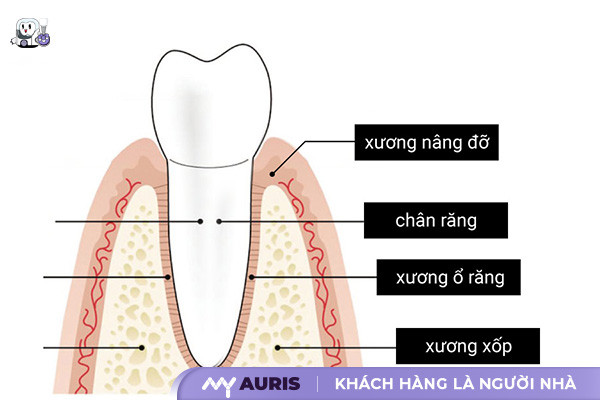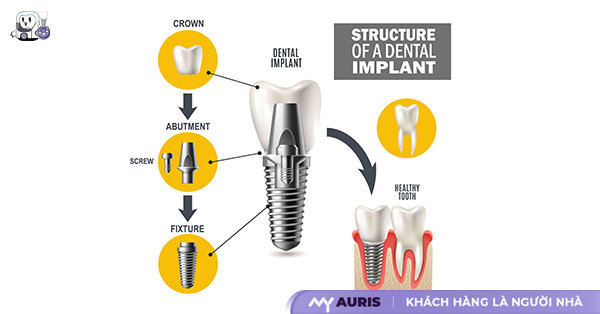Implant placement is currently an advanced dental restoration method, suitable for most cases of tooth loss, from a single tooth to a full arch. Thanks to the special structure of dental implants, this method offers numerous outstanding advantages compared to dental bridges or removable dentures, helping patients restore optimal chewing function and aesthetics.
So, what is the structure of a dental implant? What role does the implant post play in the implantation process? Let’s delve into the details in the article below to gain a comprehensive understanding before deciding on the most suitable tooth restoration method!
Structure of the Alveolar Bone
The alveolar bone is a crucial part of the oral structure, helping to keep tooth roots fixed in the dental arch. It is a complex tissue of spongy bone, enveloped by a periosteum, shaped to fit each tooth root to ensure stability.
The alveolar bone plays a fundamental role in firmly anchoring teeth to the dental arch via the periodontal ligaments. Additionally, it is responsible for absorbing and distributing forces during chewing, helping to reduce shock and protect teeth from the impact of hard foods.
The alveolar bone is divided into two main components:
- Proper alveolar bone: Consists of bundle bone and hard parts, directly in contact with the tooth root, forming the attachment point for teeth in the dental arch.
- Supportive alveolar bone: Includes cortical bone and cancellous bone, serving as the foundation to support the entire oral system, helping to maintain tooth stability.
Alveolar bone not only ensures the firmness of teeth but also helps maintain long-term oral health. When the alveolar bone resorbs, teeth are at risk of loosening or falling out, affecting chewing function and facial aesthetics. Therefore, caring for and protecting the alveolar bone is essential for maintaining a healthy set of teeth.

What is Dental Implant Placement?
Dental implant placement is an advanced dental technique where an implant post – an artificial metal tooth root – is surgically placed directly into the jawbone, perfectly replacing a lost natural tooth root. This method not only ensures the aesthetics of the implant but also restores chewing function, allowing patients to experience something similar to real teeth.
Implant surgery is applicable for various tooth loss situations, including:
- Loss of a single tooth
- Loss of multiple adjacent or non-adjacent teeth
- Full arch tooth loss requiring comprehensive restoration
However, whether an implant post can be placed depends on the jawbone condition, the patient’s overall health, and a professional assessment from the dental surgeon. A thorough examination before proceeding helps ensure durable and safe restoration results.

How Many Parts Does a Dental Implant Consist Of?
A dental implant is a comprehensive tooth restoration solution thanks to its structure consisting of three main parts: the implant post, the abutment, and the dental crown. This structure is analogous to a natural tooth, possessing a root, dentin, and enamel, providing high durability and superior aesthetics.
Implant Post (Titanium)
The implant post acts as an artificial tooth root, surgically placed directly into the jawbone, supporting the dental crown above it. This post is entirely made from pure Titanium, featuring a micro-screw shape, which facilitates rapid integration with the bone.
Currently, implant posts feature a forward-threaded surface combined with advanced processing technology, accelerating the bone cell integration process. Depending on whether it’s an incisor or molar position, the dentist will select an implant post with the appropriate size, diameter, and height to ensure long-term stability.
Abutment Connector
The abutment screw is a small metal connector that links the implant post to the dental crown. This component can be made from alloy or ceramic, serving as a tooth preparation (stump) to support and secure the crown on the implant.
The abutment is only installed after the jawbone has fully integrated with the implant post, ensuring the artificial tooth has the same stability as a natural tooth.
Dental Crown
The dental crown has a hollow core inside to fit snugly over the abutment screw, creating a tooth with a shape, color, and size identical to a natural tooth. This is the final step in the implant placement procedure, helping patients achieve a natural smile and chewing ability like real teeth.

The Role of Dental Implants in Missing Tooth Restoration
Dental implants are an optimal solution for restoring missing teeth, overcoming the drawbacks of dental bridges and removable dentures, providing high aesthetics, stable chewing function, and numerous benefits for oral health.
Maintain natural beauty and confidence in communication: Dental implants help you achieve a beautifully aligned smile, radiating confidence in daily interactions.
Restore chewing function, no dietary restrictions: Implant restoration fully restores chewing function, especially for molars. You can enjoy all types of food without dietary restrictions, unlike other methods.
Protect the digestive system, support better nutrient absorption: Dental implants help grind food effectively, assisting the body in better absorbing nutrients, thereby reducing stomach and digestive problems.
Strong durability, long implant lifespan: Thanks to their special structure, dental implants can last permanently, serving you for a lifetime with proper care.
Prevent malocclusion, protect the entire dentition: Dental implant placement fills the gaps from missing teeth, preventing tooth shifting, malocclusion, and maintaining the balance of the entire dental arch.
Preserve jawbone, prevent bone resorption: Implant placement not only restores teeth but also stimulates jawbone growth, preventing bone loss and helping the face maintain its harmonious contours over time.
Things to Know When Choosing the Right Dental Implant
Successful implant placement depends not only on the surgical technique but also on the quality of the implant materials. To ensure durable dental implants that integrate well with the jawbone and last long, you need to consider the following important criteria.
Choose Implant Posts with Clear Origin
The origin of the implant is a decisive factor in ensuring the safety and effectiveness of tooth restoration. Implant posts, abutments, and dental crowns must have quality certifications and be manufactured by reputable brands. Avoid using implant materials of unknown origin or cheap implants, as this can lead to implant failure, resulting in complications such as infection, fractured posts, or rejection. It is advisable to choose implant posts made of pure Titanium with SLA surface treatment technology, which enhances bone integration, reduces the risk of rejection, and maintains long-term stability.

Implant Posts Must Have High Bone Integration Capability
Osseointegration is a crucial process where the implant post forms a strong bond with the jawbone, ensuring the implanted tooth functions like a natural tooth. The durability of a dental implant depends on the biological connection between the post and the jawbone. The higher the integration level, the more stable the tooth, maintaining effective chewing function. A high-quality implant post accelerates the osseointegration process, shortens treatment time, and minimizes risks such as loose implants, infection, or prolonged pain.
Choose Implant Posts Suitable for the Jawbone
Each person has a different jawbone structure, so the type of implant post must be chosen accordingly. During the examination, the dental surgeon will assess bone density and advise on the most suitable implant post type for optimal restoration results. If the jawbone is weak or has undergone resorption, bone grafting may be necessary before implant placement to ensure the post’s firm attachment.
Prioritize Appropriate Implant Post Size
Implant size should be chosen based on bone condition and the location of the missing tooth. Smaller implant posts help minimize impact on adjacent teeth and accelerate bone integration, facilitating a faster healing process.

Choose a Reputable Dental Clinic
In addition to choosing the appropriate implant post, you need to ensure the procedure is performed at a specialized dental clinic with experienced and highly skilled dental surgeons.
The surgical room must be absolutely sterile and equipped with modern technology to ensure a safe implant placement process. A reputable center will help control all treatment procedures effectively, minimize complications, and increase the success rate of dental implant restoration.
Choosing the right implant post not only determines its durability but also affects long-term oral health. Prioritize implants with clear origins, posts with good bone integration capabilities, suitable for your jawbone, and performed at a reputable dental clinic to ensure successful implant placement!





